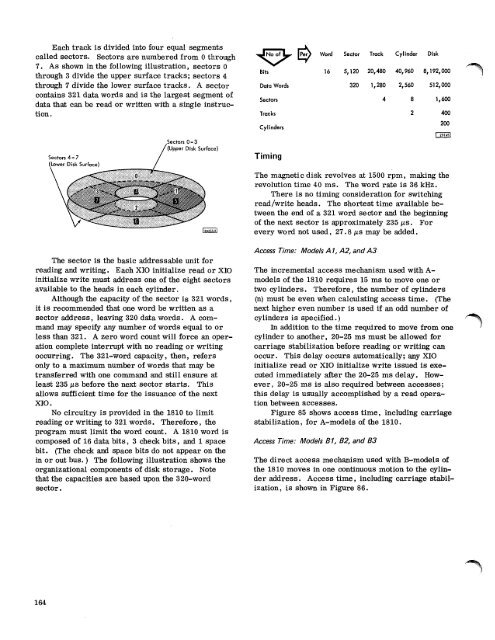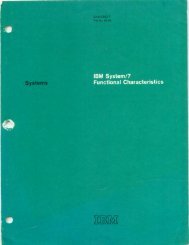Systems Reference Library - All about the IBM 1130 Computing ...
Systems Reference Library - All about the IBM 1130 Computing ...
Systems Reference Library - All about the IBM 1130 Computing ...
- No tags were found...
Create successful ePaper yourself
Turn your PDF publications into a flip-book with our unique Google optimized e-Paper software.
120255A1Each track is divided into four equal segmentscalled sectors. Sectors are numbered from 0 through7. As shown in <strong>the</strong> following illustration, sectors 0through 3 divide <strong>the</strong> upper surface tracks; sectors 4through 7 divide <strong>the</strong> lower surface tracks. A sectorcontains 321 data words and is <strong>the</strong> largest segment ofdata that can be read or written with a single instruction.BitsData WordsSectorsTracksCylindersWord Sector Track Cylinder Disk16 5,120 20,480 40,960 8,192,000320 1,280 2,560 512, 00048 1,6002400200Sectors 4-7(Lower Disk Surface)Sectors 0-3(Upper Disk Surface)Timingr 291451The magnetic disk revolves at 1500 rpm, making <strong>the</strong>revolution time 40 ms. The word rate is 36 kHz.There is no timing consideration for switchingread/write heads. The shortest time available between<strong>the</strong> end of a 321 word sector and <strong>the</strong> beginningof <strong>the</strong> next sector is approximately 235 ps. Forevery word not used, 27.8 As may be added.The sector is <strong>the</strong> basic addressable unit forreading and writing. Each XIO initialize read or XIOinitialize write must address one of <strong>the</strong> eight sectorsavailable to <strong>the</strong> heads in each cylinder.Although <strong>the</strong> capacity of <strong>the</strong> sector is 321 words,it is recommended that one word be written as asector address, leaving 320 data words. A commandmay specify any number of words equal to orless than 321. A zero word count will force an operationcomplete interrupt with no reading or writingoccurring. The 321-word capacity, <strong>the</strong>n, refersonly to a maximum number of words that may betransferred with one command and still ensure atleast 235 ius before <strong>the</strong> next sector starts. Thisallows sufficient time for <strong>the</strong> issuance of <strong>the</strong> nextXIO.No circuitry is provided in <strong>the</strong> 1810 to limitreading or writing to 321 words. Therefore, <strong>the</strong>program must limit <strong>the</strong> word count. A 1810 word iscomposed of 16 data bits, 3 check bits, and 1 spacebit. (The check and space bits do not appear on <strong>the</strong>in or out bus. ) The following illustration shows <strong>the</strong>organizational components of disk storage. Notethat <strong>the</strong> capacities are based upon <strong>the</strong> 320-wordsector.Access Time: Models Al , A2, and A3The incremental access mechanism used with A-models of <strong>the</strong> 1810 requires 15 ms to move one ortwo cylinders. Therefore, <strong>the</strong> number of cylinders(n) must be even when calculating access time. (Thenext higher even number is used if an odd number ofcylinders is specified.)In addition to <strong>the</strong> time required to move from onecylinder to ano<strong>the</strong>r, 20-25 ms must be allowed forcarriage stabilization before reading or writing canoccur. This delay occurs automatically; any XIOinitialize read or XIO initialize write issued is executedimmediately after <strong>the</strong> 20-25 ms delay. However,20-25 ms is also required between accesses;this delay is usually accomplished by a read operationbetween accesses.Figure 85 shows access time, including carriagestabilization, for A-models of <strong>the</strong> 1810.Access Time: Models 81, B2, and 83The direct access mechanism used with B-models of<strong>the</strong> 1810 moves in one continuous motion to <strong>the</strong> cylinderaddress. Access time, including carriage stabilization,is shown in Figure 86.164
















